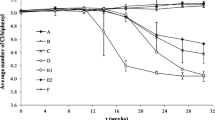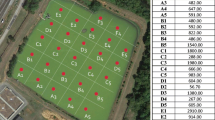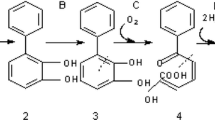Abstract
Highly chlorinated pollutants are often found in river sediments, such as in the Yangtze River. In this study, the transformation of hexachlorobenzene, pentachlorophenol, polychlorinated biphenyl (PCB), hexachlorocyclohexane and perchloroethene was demonstrated in a mixed microbial culture enriched from Xiangxi River sediment [a tributary of Yangtze River belonging to the Three Gorges Reservoir (TGR)] which contained halo-respiring bacteria. Reductive dehalogenation by the Yangtze bacteria resulted in the formation of lower chlorinated metabolites, such as tri- and dichlorobenzenes, tri- and dichlorophenols, vinyl chloride and ethene. In case of PCB180, the lesser chlorinated metabolite PCB146 was detected and is recommended for future monitoring programs. Increased gene copy numbers of dechlorinating bacteria, e.g. Dehalococcoides spp. and Desulfitobacterium spp., were observed after the transformation of the chlorinated pollutants. In conclusion, the study demonstrates the capability of Yangtze River bacteria to dechlorinate several important chlorinated pollutants, indicating efficient pollutant turnover in the TGR area.




Similar content being viewed by others
References
Abramowicz DA (1995) Aerobic and anaerobic PCB biodegradation in the environment. Environ Health Perspect 103:97–99
Adrian L, Görisch H (2002) Microbial transformation of chlorinated benzenes under anaerobic conditions. Res Microbiol 153:131–137. doi:10.1016/S0923-2508(02)01298-6
Adrian L, Hansen SK, Fung JM, Görisch H, Zinder SH (2007) Growth of Dehalococcoides strains with chlorophenols as electron acceptors. Environ Sci Technol 41:2318–2323. doi:10.1021/es062076m
Aulenta F, Bianchi A, Majone M, Petrangeli Papini M, Potalivo M, Tandoi V (2005) Assessment of natural or enhanced in situ bioremediation at a chlorinated solvent-contaminated aquifer in Italy: a microcosm study. Environ Int 31:185–190. doi:10.1016/j.envint.2004.09.014
Badea SL, Vogt C, Weber S, Danet AF, Richnow H-H (2009) Stable isotope fractionation of γ-hexachlorocyclohexane (lindane) during reductive dechlorination by two strains of sulfate-reducing bacteria. Environ Sci Technol 43:3155–3161. doi:10.1021/es801284m
Bergmann A, Bi Y, Chen L, Floehr T, Henkelmann B, Holbach A, Hollert H, Hu W, Kranzioch I, Klumpp E, Küppers S, Norra S, Ottermanns R, Pfister G, Roß-Nickoll M, Schäffer A, Schleicher N, Schmidt B, Scholz-Starke B, Schramm KW, Subklew G, Tiehm A, Temoka C, Wang J, Westrich B, Wilken RD, Wolf A, Xiang X, Yuan Y (2012) The Yangtze-Hydro Project: a Chinese–German environmental program. Environ Sci Pollut Res Int 19(4):1341–1344. doi:10.1007/s11356-011-0645-7
Carreón-Diazconti C, Santamaría J, Berkompas J, Field JA, Brusseau ML (2009) Assessment of in situ reductive dechlorination using compound-specific stable isotopes, functional gene PCR, and geochemical data. Environ Sci Technol 43:4301–4307. doi:10.1021/es803308q
Cui Z, Meng F, Hong J, Li X, Ren X (2012) Effects of electron donors on the microbial reductive dechlorination of hexachlorocyclohexane and on the environment. J Biosci Bioeng 113:765–770. doi:10.1016/j.jbiosc.2012.01.006
Demarest L (2013) Soil composition at the aquifer level, groundwater quality and the presence of Dehalococcoides ethenogenes at Dover AFB. Environ Earth Sci 71:4157–4164. doi:10.1007/s12665-013-2806-0
Dohmann M, Chen C, Grambow M, Kolditz O, Krebs P, Schmidt K, Subklew G, Tiehm A, Wermter P, Dai X, Song Y, Zheng B (2016) German contributions to the major-water program in China: innovation cluster “clean water”. Environ Earth Sci. doi:10.1007/s12665-016-5504-x
Duan TH, Adrian L (2013) Enrichment of hexachlorobenzene and 1,3,5-trichlorobenzene transforming bacteria from sediments in Germany and Vietnam. Biodegradation 24:513–520. doi:10.1007/s10532-012-9607-0
Field JA, Sierra-Alvarez R (2008) Microbial transformation and degradation of polychlorinated biphenyls. Environ Pollut 155:1–12. doi:10.1016/j.envpol.2007.10.016
Floehr T, Xiao H, Scholz-Starke B, Wu L, Hou J, Yin D, Zhang X, Ji R, Yuan X, Ottermanns R, Roß-Nickoll M, Schäffer A, Hollert H (2013) Solution by dilution?—A review on the pollution status of the Yangtze River. Environ Sci Pollut Res Int 20:6934–6971. doi:10.1007/s11356-013-1666-1
Gerritse J, Renard V, Gomes PTM, Lawson PA, Collins MD, Gottschal JC (1996) Desulfitobacterium sp. strain PCE1, an anaerobic bacterium that can grow by reductive dechlorination of tetrachloroethene or ortho-chlorinated phenols. Arch Microbiol 165(2):132–140. doi:10.1007/s002030050308
Jiang X, Martens D, Schramm KW, Kettrup A, Xu SF, Wang LS (2000) Polychlorinated organic compounds (PCOCs) in waters, suspended solids and sediments of the Yangtse River. Chemosphere 41:901–905
Kaufhold T, Schmidt M, Cichocka D, Nikolausz M, Nijenhuis I (2013) Dehalogenation of diverse halogenated substrates by a highly enriched Dehalococcoides-containing culture derived from the contaminated mega-site in Bitterfeld. FEMS Microbiol Ecol 83:176–188. doi:10.1111/j.1574-6941.2012.01462.x
Köber R, Hollert H, Hornbruch G, Jekel M, Kamptner A, Klaas N, Maes H, Mangold K-M, Martac E, Matheis A, Paar H, Schäffer A, Schell H, Schiwy A, Schmidt KR, Strutz TJ, Thümmler S, Tiehm A, Braun J (2014) Nanoscale zero-valent iron flakes for groundwater treatment. Environ Earth Sci 72:3339–3352. doi:10.1007/s12665-014-3239-0
Kranzioch I, Stoll C, Holbach A, Chen H, Wang L, Zheng B, Norra S, Bi Y, Schramm KW, Tiehm A (2013) Dechlorination and organohalide-respiring bacteria dynamics in sediment samples of the Yangtze Three Gorges Reservoir. Environ Sci Pollut Res 20:7046–7056. doi:10.1007/s11356-013-1545-9
Kranzioch I, Ganz S, Tiehm A (2015) Chloroethene degradation and expression of Dehalococcoides dehalogenase genes in cultures originating from Yangtze sediments. Environ Sci Pollut Res 22(4):3138–3148. doi:10.1007/s11356-014-3574-4
Lal R, Pandey G, Sharma P, Kumari K, Malhotra S, Pandey R, Raina V, Kohler HPE, Holliger C, Jackson C, Oakeshott JG (2010) Biochemistry of microbial degradation of hexachlorocyclohexane and prospects for bioremediation. Microbiol Mol Biol Rev MMBR 74:58–80. doi:10.1128/MMBR.00029-09
Liu C, Yuan GL, Yang ZF, Yu T, Xia XQ, Hou QY, Chen L (2010) Levels of organochlorine pesticides in natural water along the Yangtze River, from headstream to estuary, and factors determining these levels. Environ Earth Sci 62:953–960. doi:10.1007/s12665-010-0580-9
Liu M, Yang Y, Yun X, Zhang M, Wang J (2015) Occurrence and assessment of organochlorine pesticides in the agricultural topsoil of Three Gorges Dam region, China. Environ Earth Sci 74:5001–5008. doi:10.1007/s12665-015-4512-6
Löffler FE, Yan J, Ritalahti KM, Adrian L, Edwards EA, Konstantinidis KT, Müller JA, Fullerton H, Zinder SH, Spormann AM (2013) Dehalococcoides mccartyi gen. nov., sp. nov., obligately organohalide-respiring anaerobic bacteria relevant to halogen cycling and bioremediation, belong to a novel bacterial class, Dehalococcoidia classis nov., order Dehalococcoidales ord. nov. and family Dehalococcoidaceae fam. nov., within the phylum Chloroflexi. Int J Syst Evol Microbiol 63:625–635. doi:10.1099/ijs.0.034926-0
Maphosa F, de Vos WM, Smidt H (2010) Exploiting the ecogenomics toolbox for environmental diagnostics of organohalide-respiring bacteria. Trends Biotechnol 28:308–316. doi:10.1016/j.tibtech.2010.03.005
Middeldorp PJM, van Doesburg W, Schraa G, Stams AJM (2005) Reductive dechlorination of hexachlorocyclohexane (HCH) isomers in soil under anaerobic conditions. Biodegradation 16:283–290. doi:10.1007/s10532-004-1573-8
Olaniran AO, Igbinosa EO (2011) Chlorophenols and other related derivatives of environmental concern: properties, distribution and microbial degradation processes. Chemosphere 83:1297–1306. doi:10.1016/j.chemosphere.2011.04.009
Quintero JC, Moreira MT, Feijoo G, Lema JM (2005) Anaerobic degradation of hexachlorocyclohexane isomers in liquid and soil slurry systems. Chemosphere 61(4):528–536. doi:10.1016/j.chemosphere.2005.02.010
Schmidt KR, Tiehm A (2008) Natural attenuation of chloroethenes: identification of sequential reductive/oxidative biodegradation by microcosm studies. Water Sci Technol 58:1137–1145. doi:10.2166/wst.2008.729
Schmidt KR, Augenstein T, Heidinger M, Ertl S, Tiehm A (2010) Aerobic biodegradation of cis-1,2-dichloroethene as sole carbon source: stable carbon isotope fractionation and growth characteristics. Chemosphere 78:527–532. doi:10.1016/j.chemosphere.2009.11.033
Semprini L (1995) In situ bioremediation of chlorinated solvents. Environ Health Perspect 103:101–105
Tang ZW, Yang ZF, Shen ZY, Niu JF (2007) Pentachlorophenol residues in suspended particulate matter and sediments from the Yangtze River catchment of Wuhan, China. Bull Environ Contam Toxicol 78:158–162. doi:10.1007/s00128-007-9017-x
Tao Y, Yuan Z, Fengchang W, Wei M (2013) Six-decade change in water chemistry of large freshwater Lake Taihu, China. Environ Sci Technol 47(16):9093–9101. doi:10.1021/es401517h
Taş N, Van Eekert MHA, De Vos WM, Smidt H (2010a) The little bacteria that can—diversity, genomics and ecophysiology of “Dehalococcoides” spp. in contaminated environments. Microb Biotechnol 3:389–402. doi:10.1111/j.1751-7915.2009.00147.x
Taş N, Heilig HGHJ, van Eekert MHA, Schraa G, de Vos WM, Smidt H (2010b) Concurrent hexachlorobenzene and chloroethene transformation by endogenous dechlorinating microorganisms in the Ebro River sediment. FEMS Microbiol Ecol 74:682–692. doi:10.1111/j.1574-6941.2010.00972.x
Taş N, van Eekert MHA, Wagner A, Schraa G, de Vos WM, Smidt H (2011) Role of “Dehalococcoides” spp. in the anaerobic transformation of hexachlorobenzene in European rivers. Appl Environ Microbiol 77:4437–4445. doi:10.1128/AEM.01940-10
Tiehm A, Schmidt KR (2011) Sequential anaerobic/aerobic biodegradation of chloroethenes-aspects of field application. Curr Opin Biotechnol 22:415–421. doi:10.1016/j.copbio.2011.02.003
Utkin I, Woese C, Wiegel J (1994) Isolation and characterization of Desulfitobacterium dehalogenans gen. nov., sp. nov., an anaerobic bacterium which reductively dechlorinates chlorophenolic compounds. Int J Syst Bacteriol 44(4):612–619. doi:10.1099/00207713-44-4-612
van de Pas BA, Jansen S, Dijkema C, Schraa G, de Vos WM, Stams AJM (2001) Energy yield of respiration on chloroaromatic compounds in desulfitobacterium dehalogenans. Appl Environ Microbiol 67:3958–3963. doi:10.1128/AEM.67.9.3958-3963.2001
van Doesburg W, van Eekert MHA, Middeldorp PJM, Balk M, Schraa G, Stams AJM (2005) Reductive dechlorination of beta-hexachlorocyclohexane (beta-HCH) by a Dehalobacter species in coculture with a Sedimentibacter sp. FEMS Microbiol Ecol 54:87–95. doi:10.1016/j.femsec.2005.03.003
Wang S, He J (2013) Dechlorination of commercial PCBs and other multiple halogenated compounds by a sediment-free culture containing Dehalococcoides and Dehalobacter. Environ Sci Technol 47:10526–10534. doi:10.1021/es4017624
Wang J, Bi Y, Pfister G, Henkelmann B, Zhu K, Schramm K-W (2009) Determination of PAH, PCB, and OCP in water from the Three Gorges Reservoir accumulated by semipermeable membrane devices (SPMD). Chemosphere 75:1119–1127. doi:10.1016/j.chemosphere.2009.01.016
Wolf A, Bergmann A, Wilken R-D, Gao X, Bi Y, Chen H, Schüth C (2013) Occurrence and distribution of organic trace substances in waters from the Three Gorges Reservoir, China. Environ Sci Pollut Res 20:7124–7139. doi:10.1007/s11356-013-1929-x
Wu C, Zhu H, Luo Y, Teng Y, Song J, Chen M (2015) Levels and potential health hazards of PCBs in shallow groundwater of an e-waste recycling area, China. Environ Earth Sci 74:4431–4438. doi:10.1007/s12665-015-4427-2
Xi B, Su J, Sun Y, Huo S, Zheng B, Tiehm A, Kolditz O (2015) Thematic issue: water of the Taihu Lake. Environ Earth Sci 74:3929–3933. doi:10.1007/s12665-015-4732-9
Acknowledgments
The authors gratefully acknowledge the financial support of the German Ministry of Education and Research (BMBF, Grant No. 02WT1130). This study was part of the Sino-German Yangtze-Hydro Project.
Author information
Authors and Affiliations
Corresponding author
Additional information
This article is part of a Topical Collection in Environmental Earth Sciences on “Environmental Research of the Three Gorges Reservoir”, guest edited by Binghui Zheng, Shengrui Wang, Yanwen Qin, Stefan Norra, and Xiafu Liu.
Electronic supplementary material
Below is the link to the electronic supplementary material.
Rights and permissions
About this article
Cite this article
Kranzioch-Seipel, I., Beckert, U., Shen, C. et al. Microbial dechlorination of HCB, PCP, PCB180, HCH and PCE in a Yangtze Three Gorges Reservoir enrichment culture, China. Environ Earth Sci 75, 928 (2016). https://doi.org/10.1007/s12665-016-5653-y
Received:
Accepted:
Published:
DOI: https://doi.org/10.1007/s12665-016-5653-y




